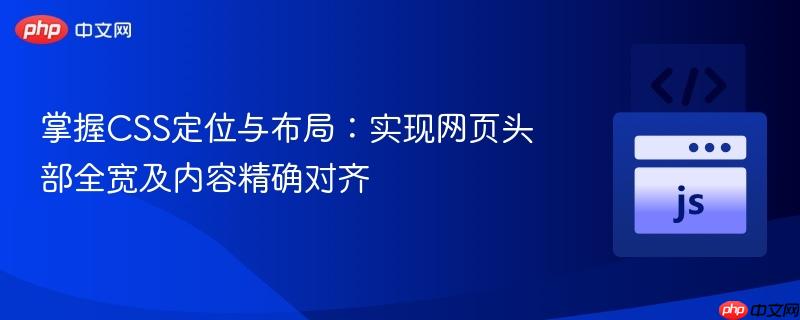
本教程将详细指导如何利用css实现网页头部(header)的全屏宽度显示,并确保内部元素(如导航栏、搜索框和图标)的合理布局。同时,我们还将探讨如何有效对齐页面主体中的图片组,通过flexbox等现代css布局技术,确保在不同屏幕尺寸下内容都能保持良好的视觉效果和响应性。
在网页开发中,实现一个占据屏幕完整宽度的头部(header)以及精确对齐页面内容,是常见的布局需求。有时,开发者会尝试使用 width: 100%; 和 position: static; 等属性,但可能无法达到预期效果。本教程将深入探讨如何通过正确的CSS定位与布局策略,解决这些问题。
在开始CSS布局之前,首先需要确保HTML结构符合语义化标准。原始代码中将
<!DOCTYPE html>
<html>
<head>
<title>Disusa</title>
<meta charset="UTF-8">
<link rel="stylesheet" href="style.css">
<link rel="stylesheet" href="https://cdnjs.cloudflare.com/ajax/libs/font-awesome/5.15.3/css/all.min.css">
<link rel="stylesheet" href="test.css">
</head>
<body>
<header class="header">
<!-- 头部内容:导航栏、搜索框、图标等 -->
<div class="navbar">
<div class="search-container">
<input type="text" placeholder="Que voulez vous comparer...">
<button type="submit"><i class="fa fa-search"></i></button>
</div>
<div class="icons-container">
<a href="#profile" class="icon-link"><i class="fa fa-user"></i></a>
<a href="#panier" class="icon-link"><i class="fa fa-shopping-cart"></i></a>
</div>
</div>
<nav class="nav">
<ul>
<li><a href="#home" id="home">Accueil</a></li>
<li><a href="#allproducts" id="project">Tout les produits</a></li>
<li><a href="#settings" id="about">Paramétres</a></li>
<li><a href="#contact" id="how">Nous contacter</a></li>
</ul>
</nav>
</header>
<main>
<!-- 主体内容:图片组等 -->
<div class="imgs_home">
<figure class="img_home">
@@##@@
<figcaption>
<h3>PC <span>Prémonter</span></h3>
</figcaption>
<a href="#pc-premonter"></a>
</figure>
<figure class="img_home">
@@##@@
<figcaption>
<h3>PC <span>Custom</span></h3>
</figcaption>
<a href="#custom"></a>
</figure>
<figure class="img_home">
@@##@@
<figcaption>
<h3>PC <span>Portable</span></h3>
</figcaption>
<a href="#pc-protable"></a>
</figure>
</div>
</main>
<script src="main.js"></script>
</body>
</html>关键修正点:
要让头部占据屏幕的整个宽度,并确保其始终位于页面顶部,可以使用 position: absolute; 或 position: fixed; 结合 width: 100%;。
立即学习“前端免费学习笔记(深入)”;
对于通常的头部,position: fixed; 更常见,因为它能确保头部在用户滚动页面时依然可见。
/* style.css */
/* 重置浏览器默认样式 */
* {
margin: 0;
padding: 0;
box-sizing: border-box;
}
body {
background-color: #ccc;
/* 为main内容预留头部空间,防止被覆盖 */
padding-top: 150px; /* 假设头部高度为150px,根据实际调整 */
}
.header {
width: 100%; /* 确保头部占据整个视口宽度 */
/* height: auto; /* 高度由内容撑开,或明确设置 */
position: fixed; /* 固定在视口顶部,随滚动保持不动 */
top: 0;
left: 0;
background-color: rgb(0, 0, 0); /* 保持与navbar相同的背景色 */
z-index: 1000; /* 确保头部在其他内容之上 */
/* 增加底部内边距,确保导航条与下方内容有间距 */
padding-bottom: 10px;
}
/* 导航条样式,保持原有flex布局以实现内部元素对齐 */
.navbar {
display: flex;
justify-content: space-between; /* 搜索框和图标容器分别靠两边 */
align-items: center;
padding: 20px;
background: rgb(0, 0, 0);
width: 100%; /* 确保navbar占据header的全部宽度 */
}
.search-container {
display: flex;
align-items: center;
width: 75%; /* 保持原有宽度 */
max-width: 600px; /* 限制最大宽度,防止过宽 */
margin: 0 auto; /* 在navbar内居中,如果navbar是space-between,这会失效 */
/* 更好的做法是:如果navbar是space-between,search-container不需要margin auto */
/* 如果希望search-container在navbar中间,可以调整navbar的justify-content为center */
}
.icons-container {
display: flex;
align-items: center;
margin-left: auto; /* 将图标推到最右边 */
}
/* 底部导航链接样式 */
.nav {
display: flex; /* 使用flex布局 */
justify-content: center; /* 导航链接水平居中 */
width: 100%;
background: var(--body-bg-color); /* 继承test.css中的背景色 */
border-radius: 100px; /* 保持test.css中的圆角效果 */
padding: 10px 0; /* 调整内边距 */
}
.nav ul {
display: flex;
list-style: none;
padding: 0;
margin: 0;
gap: 20px; /* 链接之间的间距 */
}
.nav ul li a {
color: white;
text-decoration: none;
padding: 10px 15px;
border-radius: 50px;
transition: background-color 0.3s ease;
}
.nav ul li a:hover {
background-color: rgba(255, 255, 255, 0.1);
}注意事项:
对于页面中的图片组,使用Flexbox或CSS Grid是实现响应式对齐的最佳实践。这里我们以Flexbox为例,优化 .imgs_home 容器和其内部的 .img_home 元素。
/* style.css */
.imgs_home {
display: flex; /* 启用Flexbox布局 */
flex-wrap: wrap; /* 允许图片在空间不足时换行 */
justify-content: center; /* 水平居中对齐所有图片 */
gap: 20px; /* 图片之间的间距,替代margin */
padding: 20px; /* 容器内边距 */
max-width: 1200px; /* 限制整个图片容器的最大宽度 */
margin: 0 auto; /* 容器自身在页面中居中 */
}
.img_home {
/* 移除原有的 width: 100%; max-width: 370px; */
/* 调整为更灵活的宽度,使用flex-basis */
flex: 1 1 300px; /* 允许增长、收缩,基础宽度300px */
max-width: 370px; /* 保持单张图片的最大宽度 */
/* margin: 10px; /* 如果使用gap,可以移除此处的margin */
background-color: rgb(41, 46, 57);
color: #fff;
font-family: 'Roboto', sans-serif;
font-size: 24px;
overflow: hidden;
position: relative;
text-align: center;
/* 其他原有样式保持不变 */
}
.img_home img {
width: 100%; /* 确保图片填充其父容器的宽度 */
height: auto; /* 保持图片比例 */
display: block; /* 移除图片底部默认的空白间隙 */
}
/* 媒体查询优化 */
@media screen and (max-width: 768px) {
.imgs_home {
gap: 15px;
padding: 15px;
}
.img_home {
flex: 1 1 250px; /* 中等屏幕下调整基础宽度 */
max-width: 300px;
}
}
@media screen and (max-width: 480px) {
.imgs_home {
gap: 10px;
padding: 10px;
}
.img_home {
flex: 1 1 100%; /* 小屏幕下图片占据整行 */
max-width: none; /* 不限制最大宽度 */
}
.search-container input[type=text] {
width: 100%; /* 小屏幕下搜索框输入区域全宽 */
}
}关键修正点:
实现全宽头部和精确对齐页面内容,关键在于理解和运用CSS的定位(position)和弹性盒子(Flexbox)布局模型。



以上就是掌握CSS定位与布局:实现网页头部全宽及内容精确对齐的详细内容,更多请关注php中文网其它相关文章!

每个人都需要一台速度更快、更稳定的 PC。随着时间的推移,垃圾文件、旧注册表数据和不必要的后台进程会占用资源并降低性能。幸运的是,许多工具可以让 Windows 保持平稳运行。

Copyright 2014-2025 https://www.php.cn/ All Rights Reserved | php.cn | 湘ICP备2023035733号